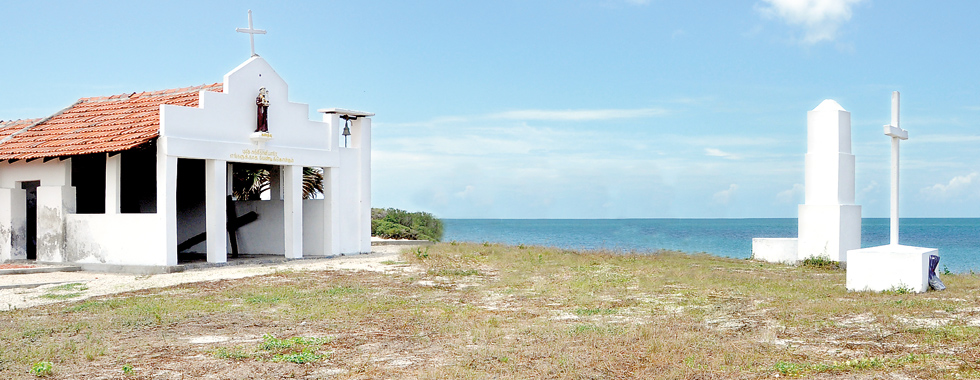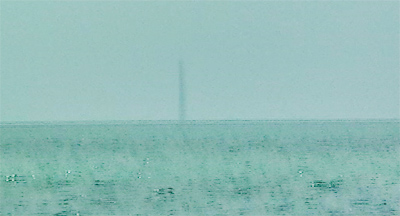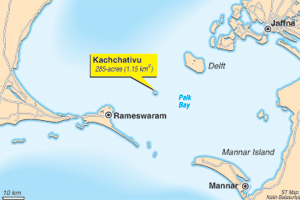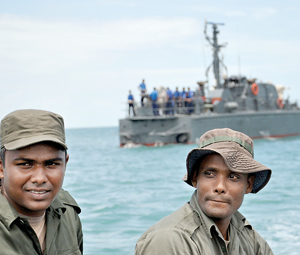News
Odyssey to our Kachchativu
Sri Lanka Navy’s fast attack craft moves out of the Northern Naval Area Headquarters in Kankesanthurai that Monday morning and cruises the calm, blue waters of the Palk Strait.
We are some three kilometres from the coast. Towering coconut trees sandwiched between buildings appear to the left. To our right, the hot sun kisses the placid waters. What looks like a giant mirror stretches to infinity.
![]()
Some ten minutes later, the lighthouse at Point Pedro towers above land. Lt. Cmdr. D.N.S. Bandara, the Commanding Officer of SLNS Thilina, manoeuvres in a northwesterly direction and goes full throttle. The thrust of the engines, more than two thousand horsepower, forces us to cling on to railings or whatever we could hold on for safety on the Weather Deck. “We are now moving at an approximate land speed of 70 kilometres per hour,” our escort Lieutenant Suranga Amith says. There is only a deep blue sea all round us.
Some 55 minutes later, the roar of engines lowers. Ahead of us, like how a distant object zooms in on a movie; a shoe brush shaped, coconut palm fringed island emerges slowly in the horizon. We weigh anchor until a Navy Inshore Patrol Craft (UIPC) reaches us for a mid-sea transfer. Some personnel on board are headed for the Navy base in Delft island that we see at a distance. The jetty, the base and the Police Station are visible at a distance.

Landmark on an island: The solitary historic Church of St Anthony with the white tower to the right-- the sentinel for fishermen at night
Moments later, the engines roar again and we have gained top speed. Behind us, the foamy water stirred by the propellers, leaves a wide white trail that resembles a highway. It is visible for a few kilometres. The caressing winds swirl as it hits us when SLNS Thilina cuts through the waters at high speed. Another 45 minutes later, the whir of engine slows. Lt. Cmdr. Bandara cruises cautiously to avoid coral growth below.
When he weighs anchor and the engines go dead, we are delighted that we had arrived at our destination. At least some two kilometres away, lies an island. We believed within moments the fast attack craft would slowly move to an alongside jetty. That was not to be. There was a chill ahead of the thrill we were going to enjoy. That it could be of life threatening proportions never dawned on us.
Heading towards SLNS Thilina was a small flat bottom fibreglass boat. There were two men wearing olive green overalls. One directs the outboard motor (OBM) whilst the other is at the fore. When it comes closer, we realise that the boat had seen better days. There was a little flooding on the tilted end of the floor where one was directing the OBM. At first, it comes alongside. Sailors on the Dvora drop ropes. Those on the boat were to hold until one after another of the Sunday Times team roped down. The idea of that “extraction” is abandoned after a quick discussion. They fear we would end up with bruises or even fall into the sea between FAC and the boat.
They agree on a second “extraction.” The boat is brought near the aft of the Dvora. From the floor, the three tier railing is three and half feet high. One has to climb to the top, climb down to the opposite side and perch their legs on the little outer area of the floor. This is whilst holding tightly to the railing. Thereafter, one holds the hand of the navy man in olive green overall, we jump slowly, four feet below to the flat bottom boat. A slip or a slight shift in direction would have been a dive into the blue sea, some 14 metres deep. Even the presence of expert sailors including divers in the Weather Deck, some holding your arm, is not comforting enough. Fear lurks in your mind that you may plunge and that may be the last chapter of your voyage.

The communication tower on Indian soil seen from Kachchativu
The “Operation Climb Down,” which bares fright in the faces, was smooth if not for one near disaster. One in the group was twice the weight of all others. When he descends, he wants to be more comfortable. So, he tries to cross from one end of the boat to the other. The boat begins to tilt heavily. Fright grips all others. The one who handled the OBM in olive green overall moves in rapidly to use his arm to divide those on board and evenly distribute weight. It is only later we learn the two men in olive green overalls are members of the Navy’s elite Special Boat Squadron (SBS). They are the commando equivalent of the Navy and are well trained.
The boat first moves towards a buoy to avoid coral growth and then banks ashore. We jump out one after another on the glistening sand. That is how we set foot on the Island of Kachchativu, the northernmost corner of Sri Lanka. A few steps away, we are first greeted by a white tower. At night, fishermen used to land to light oil lamps or candles. It has served as a sentinel for fishermen at night. Next to it lies a shallow well. A few steps away, near a solitary Palmyrah tree is the historic Church of St Anthony, the patron saint and protector of fishermen. In front is a concrete cross whilst a statue of St Anthony built in 2010 by a devotee stands between the church and the sea.
Inside the church, the clock on the wall has stopped presumably due to a dead battery. An unlit oil lamp hangs from a beam across the wall. Two statues of St Anthony stand serenely next to one of Lord Jesus Christ on wooden ledge. Two artificial flower pots lay on each side. The ledge is placed on a long cupboard built with cement with three plaques in front. Traces of salt have formed on part of the floor. Outside, a vast area is open. There is a cemented floor which bears the line “FOR VIPS ONLY”It is only once a year, in February, when the festival at the church takes place that this island becomes alive. Fishermen, both from Sri Lanka and Tamil Nadu, land in boats to transform the religious event to a trade fair of sorts. Sri Lankan devotees carry coconut oil, cardamom, cinnamon and other spices. From Tamil Nadu comes more sought after items like Sarees and Sarongs (lungis) and a variety of other items. The VIPs where temporary tents are pitched is where Government officials of both India and Sri Lanka remain seated watching the goings on, perhaps the only one of its kind in South Asia.
“When they leave these shores, they also leave behind a big problem. The food remnants left behind leads to a proliferation of rats,” says Chief Petty Officer (CPO) S.S. Nandasiri, leader of the Special Boat Squadron (SBS). He said his team is helping the National Aquatic Research Agency (NARA) which is conducting surveys to collect scientific data around Kachchativu Island. The survey covers position of fish stocks and oceanography data.

Other than the clearings – two tracks, each the size of a rural road – the other parts of the island is covered with bushy growth. The only exception is a large tamarind (siyambala) tree. With CPO Nandasiri we walk the width of Kachchativu. The only compensation for a soaring heat is the caressing wind. When it slows, one gets the feeling of being inside an oven. A few hundred metres and we arrive at a coral shore, a distinct feature that surrounds this island except for a cleared entrance. That is where we arrived by a flat bottom boat. A tall communications tower on the Indian side is clearly visible. “Our waters are only up to seven kilometres from here. The rest is Indian,” says CPO Nandasiri. The dividing waters also reflect other diversities. See box story.
In the recent months, the Island of Kachchativu has become a punching bag for politicians in Tamil Nadu. They have raised cries that the central government should seize it from Sri Lanka.
The return journey by boat to mid sea for transfer to the Dvora was less fearsome. CPO Nandasiri and colleague had by then impressed us on their skills. He oversaw “Operation Climb Up” with typical naval precision. If there was one glitch, it was overcome easily by naval personnel on board. They helped a member of the Sunday Times team by raising his leg to clear the railing. One leg was firmly on the Weather Deck and the other was outside across the railing. Thereafter, it was full steam ahead back to the naval headquarters in Kankesanthurai.
Cats and mice: A rodents’ playground
The Island of Kachchativu, the northernmost part of Sri Lanka, lays bare an interesting feature. A walk across the breadth of the island, towards India, sees one’s mobile telephone switching to an Indian network. This is for mobile phones which have international roaming facility.
When at the other end where the Church of St Anthony is located, mobile phone services locally operated are quite clear.
Who lives in Kachchativu? “Two domestic cats, a few lizards (Katussas) and plenty of mice,” says Chief Petty Officer S.S. Nandasiri, head of the Navy’s elite Special Boat Squadron (SBS) who are stationed there. They are assisting the NARA in a survey.

The two Special Boat Squadran men who steered the flat bottom fibre glass boat that took the Sunday Times team to Kachchativu seen in the foreground, while the Dvora that brought the team to mid sea is seen in the background
He said the mice have bred with the left-over food both Sri Lankan and Indian devotees bring to the island during the festival. The two domestic cats were brought by the Navy team. They live there sharing food cooked from the SBS men’s rations as well as chasing mice.
The Kachchativu Agreement – a brief history
- Both countries lay claim to the island of Kachchativu. Sri Lanka produced ancient historical records saying that even the Portuguese administered Kachchativu as part of the Jaffna peninsula, while the Indian side it was ruled by the Rajah of Ramnad Zamindari of the Ramanathapuram Principality.
- The first formal discussions for the ownership of the Kachchativu island, North West of Sri Lanka and South East of India was in 1921. It was called the 1921 Fisheries Line. Discussions were held between the colonial British Governments of Madras and Ceylon. Interestingly, it recognised “the need to avoid over-exploitation” and to take measures for the conservation of the marine resources and the possibility of fishermen competing in the same waters for their catch – the same issues today.
- A Joint Report was submitted on October 21, 1921.The line of demarcation commenced from the entrance to the Palk Strait at mid-point from Point Pedro (Sri Lanka) and Point Calimere (India). The British Government of India did not ratify this Agreement however. After India and Sri Lanka gained Independence, the issue arose again in the 1960s. Prime Ministers Dudley Senanayake and Indira Gandhi held the first summit level talks on Kachchativu in 1968 in New Delhi and also in London after a CHOGM summit. The Prime Minister of Ceylon refused to compromise on the subject and suggested international arbitration, but the Indian Prime Minister did not want third party adjudication on the issue.
- When Sirima Bandaranaike came into office in 1970, she made resolving the issue of Kachchativu and demarcating the maritime boundary of Sri Lanka an integral element in the gamut of Indo-Lanka relations in addition to her Indian Ocean Peace Zone proposal at the UN.
- The Attorney General of India gave an opinion to the Prime Minister of India, that “on balance, the sovereignty of Kachchativu was and is with Sri Lanka”. Describing his counterparts from Sri Lanka, Thomas Abraham, a former Indian High Commissioner in Colombo, wrote in a foreword to a book on Kachchativu by an Indian professor; “Skillful and tenacious, they could unerringly spot the weakness in an argument or fact, the loss of nerve or the lack of interest on the other side. It would be hard to beat them in their grasp of intricacies of problems and the clear goals they had”. The Sri Lankan negotiators included G.V. P. Samarasinghe, Siri Perera QC (from 1968-70) and C.W. Pinto, Legal Advisor to the Ministry of External Affairs, W.T. Jayasinghe, Vernon Mendis, Ben Fonseka, Justin Siriwardene, Bernard Tillekeratne, Dr. H.A de S. Gunasekera and officials from the Survey Dept., S.T. Herath and R.D.F.A. Fonseka.
- After protracted negotiations at diplomatic, technical and political levels an agreement was reached to ‘concede’ (as opposed to ‘cede’) Kachchativu to Sri Lanka. Ms. Bandaranaike signed the agreement on June 26, 1974 and Ms, Gandhi signed the same copy on the 28th of that month.
- India’s External Affairs Minister Y.B. Chavan told the Indian Parliament, “Fishing vessels and fishermen of one country shall not engage in fishing in the waters of the other”. Article 5 of the Agreement said; “Indian fishermen and pilgrims will enjoy access to Kachchativu as hitherto (for the St. Anthony’s church pilgrimage and to dry nets), and will not be required by Sri Lanka to obtain travel documents or visas” — clearly meaning that the island belonged to Sri Lanka.
- Tamil Nadu politicians in India have begun a fresh campaign to what they call “retrieve” ownership of the island of Kachchativu. The state Government’s official records say it is “the topmost agenda of the Tamil Nadu Government”. Its report says the island was ceded ‘unilaterally’ by the Government of India. A resolution was passed in the Tamil Nadu Legislative Assembly in 2011 and the Chief Minister J. Jayalalithaa filed a writ petition W.P. (Civil) No. 561/2008 in the Supreme Court of India in 2008 for the “retrieval” of the island.
- The Government of India in an affidavit filed in the Indian Supreme Court states, “No territory belonging to India was ceded nor sovereignty relinquished since the area in question was in dispute and had never been demarcated. Therefore, the contention (of Ms. Jayalalithaa) that Kachchativu was ceded to Sri Lanka was not correct and contrary to official records”.
1. The 1974 maritime agreement settling all outstanding disputes over the island of Kachchativu saw the creation of an International Maritime Boundary Line (IMBL) at the half way mark (Point Pedro in Sri Lanka and Point Calimere in India were taken as the two points) of the waters of the Palk Bay/Palk Strait that separates the two countries.
2. The agreement allowed Indian fishermen free access to the island of Kachchativu crossing the IMBL only to dry nets and participate in the annual religious (Catholic) festival at a small church of St. Anthony’s. No fishing was allowed to Indian fishermen.
3. There was no agreement of any kind thereafter between the two sides on the IMBL matter or fishermen issues. The unwritten understanding between India and Sri Lanka was that fishermen who “inadvertently strayed” across the IMBL “will be treated humanely”. When the northern insurgency in Sri Lanka was in its initial stages under the J.R. Jayewardene Presidency, India proposed licensing of fishermen in each other’s waters, but the proposal was rejected by Sri Lanka and it never came up for discussion.
4. When Indian fishermen poached in Sri Lankan waters, Sri Lankan fishermen in the North were able to fend them off, often with the assistance of the Sri Lanka Navy. Post-1983, the LTTE then began employing Indian fishermen to ferry fuel, medicines, ammunition and wounded guerillas across the Palk Straits at the height of the insurgency. They had a few fish on board, and when accosted would throw the contraband overboard and play ‘innocent fishermen’.
5. However, in October, 2008 India brought the matter up when Economic Development Minister Basil Rajapaksa, then Presidential Adviser and Special Envoy visited New Delhi. It was at a time when Sri Lanka was ‘at war’ with a full scale terrorist campaign for a separate state. A joint statement was issued from New Delhi that the Minister had agreed to put in place ‘practical arrangements’ to deal with “bona fide fishermen” crossing the IMBL. This opened the door for what is now a concerted effort by ‘mala fide fishermen’ crossing the IMBL in their thousands.
6. A separate India-Sri Lanka Joint Statement on Fishing Arrangements was issued simultaneously where it was agreed that there will be no firing on Indian fishing vessels. This has given the poachers a sense of security to enter Sri Lankan waters illegally at will.
7. This arrangement called for the working of an MoU on development and cooperation in the field of fisheries. The Joint Working Group between the two countries has not met for several months despite repeated requests by the Sri Lankan side for a resumption of talks. After the January 2012 meeting of the Joint Working Group, the Sunday Times pointed out to the joint statement that was issued stating that while the Sri Lankan side “stressed” on the issue of Indian fishermen poaching, India had kept silent. The Sri Lankan Ministry of External Affairs issued a statement shortly thereafter discounting “media reports” and brought in the wording “the issue of traditional fishing rights”, an argument of the Indians, and referred to the “genuine desire” of both countries to allow fishermen to “pursue their fishing activity in a safe, secure and sustainable manner”.
8. Thousands of Indian fishermen, mostly from Tamil Nadu continue crossing the IMBL into Sri Lankan waters thrice a week. Sri Lankan fishermen are forced to keep away from earning their livelihood on these days fearing for their lives and property. Efforts are afoot to make the three days of poaching a permanent, agreed feature.
9. The Sri Lankan Government has invited representatives of Indian fishermen unions to visit Colombo for talks, but they have been prevented from doing so by the Tamil Nadu state Government, which in turn has made unofficial announcements that they will invite Sri Lankan fishermen unions to Chennai.

